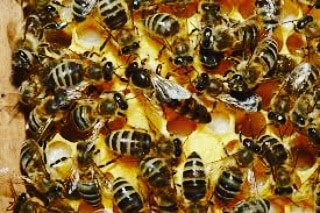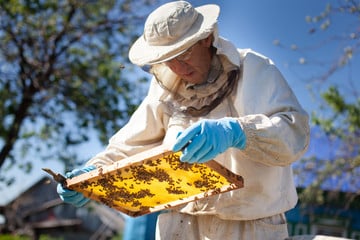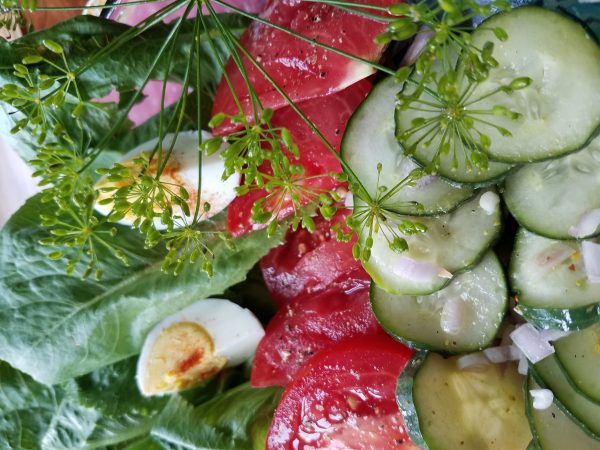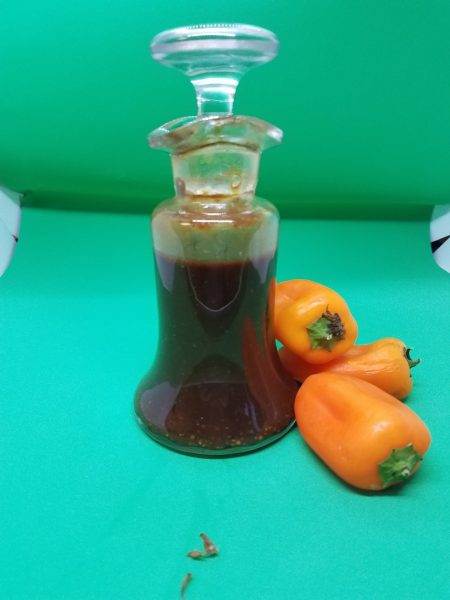
The Lord hates everyone who is arrogant; he will never let them escape punishment. Proverbs 15,16
“What was I thinking when I ventured into beekeeping?” Looking back, my decision was skewed with myths, misinformation and arrogance.

I considered myself an amateur naturalist. I camped and fished and hiked beaches and forest trails. My rumpled copy of Roger Tory Peterson’s bird identification book is found under the front seat of my car alongside binoculars. I voted for clean air and water and preservation of prairies, the barrier reefs and old growth forests. I am a past member of the Audubon Society; and, once, when I lived in Minnesota, I voted for a candidate of the Green Party.
I count bees as premier naturalists. They pollinate 1/3 of the vegetables and fruits marketed in the U.S., process the nectar into honey, a tasty and even medicinal product, and they willingly offer up their excess for humans to eat.
In my state of innocence, I believed this to be true.
“What is the risk,” I asked.
The investment seemed minimal. The beehive could be set up on marginal land that required no rent; and wild flowers are free. If I started small, one hive, what could go wrong?
Thinking casually, I concluded that beekeeping would entertain me like fishing, gardening, bird watching – my other hobbies.
I pictured myself gifting combs dripping with ambrosia (honey) to family, neighbors and clients, and bowing in humility at their profuse expressions of gratitude and admiration for me, the beekeeper.
Beekeeping Workshop
On a Saturday in January, driving thirty miles across flat farmland in blowing snow to sit on a metal folding chair in a Buffalo County Extension classroom to hear an etymologist lecture on beginning beekeeping seemed reasonable.
Knowing nothing about the craft and the business of bees, I walked blithely through the door in time to hear Dr. Ellis, the etymologist and apiary specialist, ask the first question of the class, “Why are you here?”
.
The dialogue that ensued revealed that all other participants lived on an acreage or a farm. One was a truck gardener and needed bees to pollinate the vegetables in his garden; others lived on farms and hoped to sell honey to augment their incomes; another had an opportunity to buy into a commercial beekeeping business and intended to start with 800 hives. The instructor shook his head as he said, “Not a good idea. Start with two hives and learn from the bees.”
I then heard myself saying that I intended to start beekeeping as a hobby. “I like working outside and being around plants,” I said. “I believe caring for bees will be fulfilling and somewhat like gardening.” I noticed a slight twitch in Dr. Ellis’s eyebrows.
I considered bees to be mediums between God and wild flowers, and beekeeping a business involving minimal work or investment. Bees did the work and nature supplied the raw material, flowers.
My First Summer
My first summer as a beekeeper, I saw my one hive (two deeps and twenty frames) increase from 6,000 bees
arriving in a box no larger than a milk carton, to its current estimate of maybe 60,000 bees. Healthy and productive hives build up their populations to around 70,000 bees by mid-summer and the time of the honey flow.
During the honey flow, when the most flowers are producing the most nectar, the bees gather nectar, and make honey.
Beekeeping for Dummies
I visited the hive nearly weekly, pried apart the frames and viewed the young bees cleaning comb, feeding larvae, and capping cells of honey and pollen. I compared my observations with advice written in beekeeping journals and books like Beekeeping for Dummies.
My friend, Larry Slack, a commercial beekeeper who managed over 2,000 hives in the Platte River valley advised checking the hive during the hottest, brightest part of the day since the worker bees will be in the alfalfa fields and the only bees in the hive are the nurse bees and baby bees. Larry said, “Young bees don’t defend the hive like worker bees.”
I was eager for the harvest and the first taste of honey from the hive.
“Oh, Well,” I said.

On August 1, 2004, a hot Sunday afternoon, I decided to drive to the apiary and harvest the honey. I was sure it would be ready. It was a happy prospect even though the afternoon had melted away, and the sun’s rays slanted in the late summer sky. “Oh, well,” I reasoned. “The day is hot, and the sun still bright.” Ignoring Larry’s advice, I figured the powerful worker bees would be in the field working late because the sun was lingering long in the western sky.
I might have died that day!
When I arrive at the apiary, it is nearly 5:30 p.m. Clusters of bees are flying in and out of the hive. I park parallel to the hive, shred pieces of burlap into the smoker, fire up the smoker, don white coveralls, and exchange sandals for socks and canvas shoes. I set the bee veil over my wide brimmed hat, lace it through the loop on the front of my bee suit, tie the strings securely around my waist, and bend own to fasten a strap around my pants legs. I feel secure as I approach the hive and lift the top cover.
Bees churn out of the honey super, and a high-pitched scream reverberates over my head. With my hive tool, I pry a frame up and hold it to the sky. Yes! I see white wax indicating freshly capped cells of honey. The honey is finished and ready to harvest.
Now, how do I remove the bees? I want them off the honey frames. I grab my bee brush, a brush with soft fine bristles. I begin sweeping the bees off the frame, and work slowly and carefully to avoid injuring these fine productive bees.
I feel the tapping feet of a bee crawling across my nose.
I’m holding the second frame in my hands when I feel the tapping feet of a bee crawling across my nose. Alert to signs of trouble, I lay the frame and the brush on the hive. Then I feel masses of bees crawling on my face and neck. I rip off the head gear to clear the bees off my face. A thousand bees descend on my head and twist like corkscrews into my hair. I rip my fingers through my hair pulling out bees and throwing them into the air. Attackers swoop and dive and brilliant flashes of pain inform me that my neck is the battleground. I back up and turn to run the fifty yards between the county road and the beehive.
I am retreating with a cloud of suicide bombers attacking my head and neck. When my feet hit the gravel road, the bees claim victory and turn back to the hive. I rake my hair again and again trying to extricate the buzzing swarm still caught in the strands.
Thinking only of escape, I need to return to the hive to get to my car. A cloud of bees still swirls above the hive. Cautiously, I walk toward the car, and before 25 yards, the bees see me approach and attack again. I scramble back to the road and uncertain safety.
I am feeling frantic now, near panic. My lungs are pumping, my heart’s throbbing, and my neck is swelling from the venomous stings. I am in enemy territory, far from human habitation, and the bees are blocking my route to safety. To escape, I must reclaim my car.
Slowly and methodically, I close the 2 snaps below the collar of the bee suit, place the veil over my head and lace it under the collar. I pump the bellows of the smoker until thick smoke pours out of the nozzle. Nearing the hive, a cloud of bees rises into the air, assaulting my ears with an orchestrated scream like hundreds of angry clarinets, and they descend to fight again. I pump smoke at them, but to no avail.
As I approach the car, clusters of bees swirl around the driver’s door and follow me overhead to the passenger door. Pumping all the while on the bellows of the smoker, I smoke the door, open it and throw myself into the car, jerking the door closed, and I breathe.
Oh, No! I notice the open hive!
I can see the bees boiling out of the hive, and I can hear their angry whine through closed windows. I wonder why they aren’t settling down and getting back to their work program as they were supposed to do. Sweat trickles down my bleeding and swelling neck as I notice the open hive.
They cannot protect their exposed hive from robber bees, marauding skunks, cold or rain. I need to close up the hive.
I reassemble my gear and with special care, quietly slip out the passenger door of the car. I reignite the smoker and pick up the frames of honey to return them and close the hive. I accomplish my task and take off running again to the road with a battalion of bees chasing me.
As I run, I can feel my neck swelling, and a frightening thought occurs that an allergic reaction may be happening. I need to get back to Holdrege, fast. I return to the car, the bees close ranks around the driver’s door, and a swarm of screaming bees follows me around to the passenger side. I smoke the car door and the handle and crack the door only wide enough for me to slip in again.
I swallow a Benadryl
Fifty yards down the county road, I stop the car, dump the smoldering burlap out of the smoker, swallow a Benadryl that I keep among the bee supplies, take off the coveralls and bee veil, and pack them in the trunk. Thirty more miles, I think. Thirty more miles to home.
I sustained hundreds of stings. I couldn’t count them. I felt chilly and sweaty, hot and cold. When I arrived home, I swallowed another Benadryl, drank a quart of water, vomited into the toilet, and stumbled into bed where I slept and woke and slept again for 48 hours.
Arrogance led to carelessness
Two days later, when I felt well enough to get out of bed, I called my friend Larry, the commercial beekeeper. I swallowed a huge dose of humility and told him about the catastrophe. There was a pause and a sympathetic, “Oh, my.” Then he said, “Never dig into bees in late afternoon because the field bees are home!” I had heard this advice before.
Weeks later when my neck felt normal and the scabs had healed, I pondered the messages and lessons of this near death experience. Why did I disregard the advice of an experienced beekeeper? I concluded that my arrogance led to carelessness, and my brash behavior harmed the bees and certainly me.
Wendell Berry, farmer/philosopher/poet writes in his book, What Are People For, “We forget that….. nature includes us, and we are in it and part of it while we use it.”
With Mother Nature’s fury vividly imprinted in my mind and body, I will remember forever the time when I disregarded her and her rule to respect her wild things. Ouch!
______________________________________________________________________________________
Summer 2019 Update: In 2007 I replaced the Italian queens with Carnolian queens, a gentler breed, I think, and most important, I purchased a one piece bee suit in which the veil zips onto the coveralls.
I feel invincible. Oh my, arrogance resurfaces, and I am doomed.
With the advice and sometimes assistance of George Bunnell, a commercial beekeeper in Oxford, NE, an apiary of 6 hives produce upwards of 200 lbs. wildflower honey per season.
========================================================================================

Spring Green Crunch

Spicy Beer Mustard Dressing and Spring Garden Crunch
What You'll Need:
- 4 cups lettuce, kale, Swiss Chard, parsley, mint, basil
- 1 cup cherry tomatoes or early tomatoes sliced cut in half
- 6 spring green onions sliced thinly
- 6 radishes shaved (sliced thin, thin)
- handful chives and/or dill mince chives and leave dill whole
- 8 sugar snap peas chopped
- 6 Persian cucumbers or small cucumbers or 1 English cucumber cut in chunks
- 4 hard boiled eggs (optional) cut in half
SPICY BEER MUSTARD - Vinaigrette Dressing
- ¼ cup Spicy Beer Mustard
- ¼ cup Balsamic Vinegar
- ¼ cup Soy Sauce
- ¾ cup olive oil
- pinch salt or to taste
How To Prepare:
Constructing the Salad
- Tear greens into bite-sized pieces and also massage the Kale before tearing. Slice the remaining garden vegetables, peel the eggs and slice in halfChoose a platter and arrange the vegetables and eggs by the row on the platterCover and chill in refrigerator and may be prepared several hours prior to serving
Spicy Beer Mustard Vinaigrette
- Delightfully simple instructions: select a 2 cup bowl or jar, mix Spicy Beer Mustard, Balsamic Vinegar, Soy Sauce, pinch of salt and stir with a wire whip or shake the jar to mix then drizzle the olive oil into the mixture stirring the bowl or shaking the jar until an emulsion forms. The dressing will be thick enough to coat a spoon. Taste and season as you like.
Serving the crunchy Green Salad
- Serve in the platter with tongs so that guests may help themselves to the level of crunch desirable. Pass the Spicy Beer Mustard Vinaigrette. See the smiles when the flavor touches tongue!

Garden Chives
